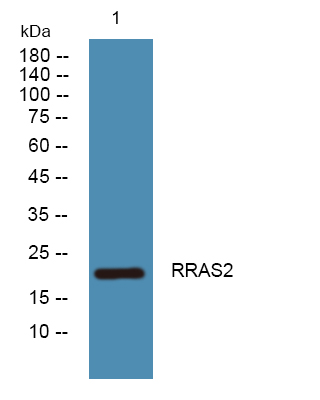RRAS2 Polyclonal Antibody
- Catalog No.:YN1192
- Applications:WB;ELISA
- Reactivity:Human;Mouse
- Target:
- RRAS2
- Fields:
- >>MAPK signaling pathway;>>Ras signaling pathway;>>cAMP signaling pathway;>>Phospholipase D signaling pathway;>>Mitophagy - animal;>>Autophagy - animal;>>Cellular senescence;>>Apelin signaling pathway;>>C-type lectin receptor signaling pathway;>>Regulation of actin cytoskeleton;>>Proteoglycans in cancer
- Gene Name:
- RRAS2 TC21
- Protein Name:
- Ras-related protein R-Ras2 (Ras-like protein TC21) (Teratocarcinoma oncogene)
- Human Gene Id:
- 22800
- Human Swiss Prot No:
- P62070
- Mouse Swiss Prot No:
- P62071
- Immunogen:
- Synthesized peptide derived from human protein . at AA range: 90-170
- Specificity:
- RRAS2 Polyclonal Antibody detects endogenous levels of protein.
- Formulation:
- Liquid in PBS containing 50% glycerol, and 0.02% sodium azide.
- Source:
- Polyclonal, Rabbit,IgG
- Dilution:
- WB 1:500-2000 ELISA 1:5000-20000
- Purification:
- The antibody was affinity-purified from rabbit antiserum by affinity-chromatography using epitope-specific immunogen.
- Concentration:
- 1 mg/ml
- Storage Stability:
- -15°C to -25°C/1 year(Do not lower than -25°C)
- Observed Band(KD):
- 22kD
- Background:
- This gene encodes a member of the R-Ras subfamily of Ras-like small GTPases. The encoded protein associates with the plasma membrane and may function as a signal transducer. This protein may play an important role in activating signal transduction pathways that control cell proliferation. Mutations in this gene are associated with the growth of certain tumors. Pseudogenes of this gene are found on chromosomes 1 and 2. Alternate splicing results in multiple transcript variants. [provided by RefSeq, Apr 2010],
- Function:
- disease:Defects in RRAS2 are associated with ovarian cancer [MIM:167000]. Ovarian cancer is the leading cause of death from gynecologic malignancy. It is characterized by advanced presentation with loco-regional dissemination in the peritoneal cavity and the rare incidence of visceral metastases. These typical features relate to the biology of the disease, which is a principal determinant of outcome.,function:It is a plasma membrane-associated GTP-binding protein with GTPase activity. Might transduce growth inhibitory signals across the cell membrane, exerting its effect through an effector shared with the Ras proteins but in an antagonistic fashion.,PTM:May be post-translationally modified by both palmitoylation and polyisoprenylation.,similarity:Belongs to the small GTPase superfamily. Ras family.,subcellular location:Inner surface of plasma membrane possibly with attachment requiring
- Subcellular Location:
- Cell membrane ; Lipid-anchor ; Cytoplasmic side. Golgi apparatus membrane ; Lipid-anchor .
- Expression:
- Ubiquitously present in all tissues examined, with the highest levels in heart, placenta, and skeletal muscle. Moderate levels in lung and liver; low levels in brain, kidney, and pancreas.
- June 19-2018
- WESTERN IMMUNOBLOTTING PROTOCOL
- June 19-2018
- IMMUNOHISTOCHEMISTRY-PARAFFIN PROTOCOL
- June 19-2018
- IMMUNOFLUORESCENCE PROTOCOL
- September 08-2020
- FLOW-CYTOMEYRT-PROTOCOL
- May 20-2022
- Cell-Based ELISA│解您多样本WB检测之困扰
- July 13-2018
- CELL-BASED-ELISA-PROTOCOL-FOR-ACETYL-PROTEIN
- July 13-2018
- CELL-BASED-ELISA-PROTOCOL-FOR-PHOSPHO-PROTEIN
- July 13-2018
- Antibody-FAQs
- Products Images

- Western blot analysis of lysates from SH-SY5Y cells, primary antibody was diluted at 1:1000, 4°over night



